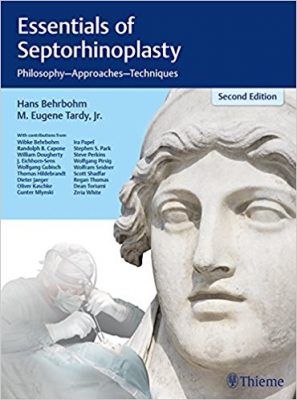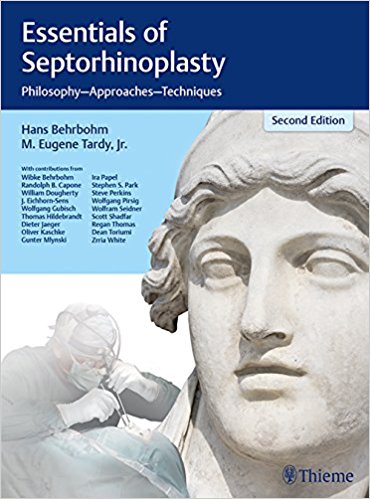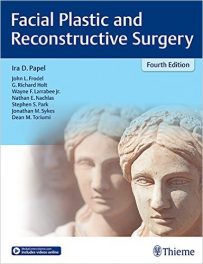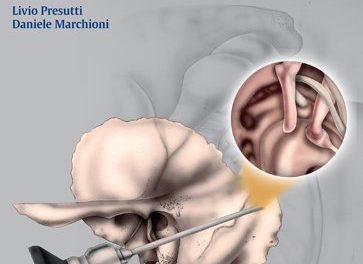 Editors: Hans Behrbohm, MD; and M. Eugene Tardy, Jr., MD
Editors: Hans Behrbohm, MD; and M. Eugene Tardy, Jr., MD
Publisher: Thieme – 262 pages
Book Review by: Nano Khilnani
Rhinoplasty has become more common in the modern world, with people wanting to have a better-looking nose. However, there are other reasons when this procedure is not optional but necessary: congenital defects, correcting a failed previous plastic surgery, injury, or respiratory impediment.
Septoplasty meanwhile is a reconstruction of the septum, the partition between the two nasal cavities. The septum normally runs straight in the center, but in some cases, such as a birth defect, it deviates and is crooked, sometimes impeding airflow.
Septorhinoplasty combines the two surgical procedures in order to improve the internal functions of the nasal cavities and the external appearance of the nose.
Twenty-one specialists in facial plastic and reconstructive surgery, otolaryngology-head and neck surgery, and otorhinolaryngology, from the United States, Germany and Switzerland, authored the 15 chapters of this large-sized (12” x 9”) book, which we list below to give you an overview of its contents:
- The Dual Character of Nasal Surgery
- Contemporary Rhinoplasty: Personal Principles and Philosophy
- Facial Proportions and Aesthetic Ideals in Rhinoplasty
- Physiology and Pathophysiology of Nasal Breathing
- Preoperative Management
- Principles of Modern Septoplasty
- Structural Grafting via the External Rhinoplasty Approach
- Endonasal Tip Rhinoplasty Approaches and Techniques
- Alar Reduction and Sculpture
- The Deviated Nose
- The Functional Tension Nose, the Overprojected Nose
- The Saddle Nose – Causes and Pathogenesis, Approaches and Operative Techniques, Principles of Tissue Replacement in the Nose
- Rhinoplasty After Cleft Lip Repair
- Nasal Trauma
- Postoperative Care and Management
Treatments for the plastic repair of a broken nose, according to a Wikipedia article, are first mentioned in the Edwin Smith Papyrus, a transcription of an ancient Egyptian medical text, the oldest known surgical treatise, dated to the Old Kingdom from 3000 to 2500 BC. Rhinoplasty surgical techniques are also recorded as being carried out in ancient India by the ayurvedic physician Sushruta, who described reconstruction of the nose in his medico-surgical compendium, around 500 BC in the Sushruta Samhita.
Among the important features of this book are the following:
- New and expanded discussion of biostatic surgery, submucosal septal surgery, radiofrequency surgery, endoscopic procedures, and diced cartilage and fascial (DCF) implants
- Step-by-step discussion of operative procedures, including the latest graft and suture techniques
- More than 600 exquisite illustrations and high-quality photographs that enhance the text
- Contributions from renowned names in the field of otolaryngology and facial plastic surgery
A core chapter in this book is chapter 6 entitled Principles of Modern Septoplasty. It deals with underlying principles that help the surgeon view the nasal septum (described a partition between two cavities) “within the context of complex rhinosurgery and take into account the long-term effects of specific procedures. Viewed in this manner, procedures on the nasal septum should actually not be considered as operations for beginners,” write the author of this chapter Dr. Thomas Hildebrandt.
In his Introduction the author describes the primary function of the cartilaginous septum much like a tent pole “which provides suspension for the upper lateral cartilages, and anchors the anterior nose to the facial skeleton.” He points out that most nasal deformities are associated with the septum’s key role in the overall framework of the nose.
So the outline of this chapter’s contents are as follows:
Introduction
- Indications
- Contraindications
- Preoperative Considerations
- Septum and Turbinates
- Structural Implications
- Preoperative Analysis
- Surgical Technique
References
There are only a few textbooks available on the market on septorhinoplasty and this is one published by Thieme of the fewer ones with a second edition. We aim to feature in this space, reviews of books on subjects that are uncommon.
This is certainly an uncommon book that provides extensive coverage of septorhinoplasty and the many topics and issues within this medical and surgical specialty. Like any great book on surgery of any kind, this one has a large number of excellent full-color images such as charts, fine-line drawings, tables, and of course photos, including those of patients and how their functional and aesthetic problems were solved.
Editors:
Hans Behrbohm, MD, PhD is Professor and Director of the Department of Otolaryngology, and Facial Plastic Surgery at Park-Klinik Weissensee Teaching Hospital of the Charite University Hospital in Berlin, Germany.
Eugene Tardy, Jr., MD, FACS is Professor Emeritus and Former Director of the Division of Plastic and Reconstructive Surgery at the University of Illinois at Chicago in Chicago, Illinois.
Contributors:
Wibke Behrbohm; Randolph B. Capone, MD, FACS; William Dougherty, MD; J. Eichorn-Sens, MD, PhD; Wolfgang Gubisch, MD, PhD; Mario Hensel, MD, PhD; Thomas Hildebrandt, MD; Dieter Jaeger; Oliver Kaschke, MD; Gunter Mlynski, MD; Ira D. Papel, MD, FACS; Stephen S. Park, MD; Stephen W. Perkins, MD; Wolfgang Pirsig, MD; Wolfram Seidner, MD; Scott Shadfar, MD; M. Eugene Tardy, Jr., MD, FACS; J. Regan Thomas, MD; Dean M. Toriumi, MD; and Zrria L. White, MD.







